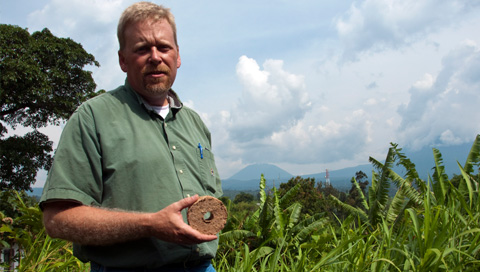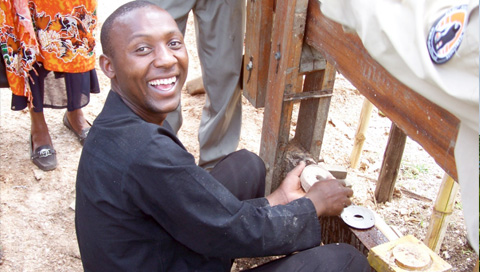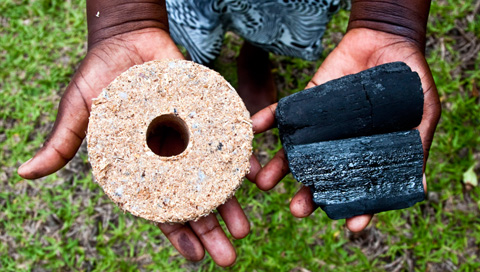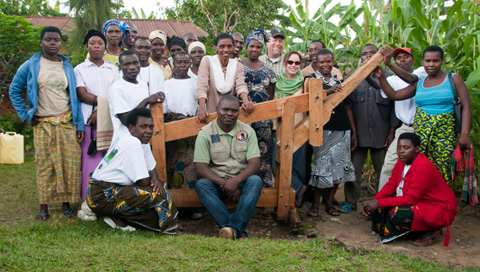Alternative Fuel Helps Gorillas!
By Gorilla Doctors Staff on Wednesday, January 27th, 2010 in Uncategorized.Blog by: John Huston
Agriculture Project Coordinator – MGVP One Health Program
One of the greatest threats to the mountain gorillas living in Virunga Massif is charcoal. This may sound odd at first, but let me explain the connection.
 John Huston in Rumangabo investigating fuel briquette technology.
John Huston in Rumangabo investigating fuel briquette technology.
People need a fuel source to heat their homes and to be able to cook food and boil water, and, in this part of the world, they use charcoal. Charcoal is the primary fuel source because very few homes have access to electricity and very few families can afford it where it is accessible. Charcoal, however, is relatively cheap, and in this region of lush forests, it’s easy to get the raw materials necessary for manufacturing.
Burning charcoal and wood seems to make sense on the surface because, after all, it is a renewable resource. Unfortunately, the demands of overpopulation in this region have resulted in massive deforestation to create opportunities for the cultivation of food. There is some agro-forestry but an alarming proportion of the available charcoal is from trees that have been cut illegally in protected areas, the national parks of the Virunga Massif where mountain gorillas live.
Besides destroying wildlife habitat, the illegal park entries create opportunities for disease transmission between humans and non-human primates. Participants of the illegal charcoal trade utilize poaching as a source of food while in the forest. Many of the poor people of the region are exploited and forced to participate in transport of this illegal product from the forest to the urban areas of the Democratic Republic of Congo (DRC) and Rwanda. The continuous demand from the human population for fuel has helped this illegal enterprise evolve to a 30-million-dollar business in the city of Goma, DRC alone.
One way to protect the gorillas within the forest is to improve the livelihood for people living nearby. We work closely with individual farm families in many communities near the Virunga Massif to help them shift from subsistence agriculture to more sustainable living. One effort involves the development of small business opportunities that will increase cash flow to the family.
Another way to protect the gorillas within the forest is to teach environmentally friendly practices throughout the rural communities. One of the environmentally friendly practices that we support is the use of alternative fuels. The most talked about alternative fuel in this region is bio-gas. Bio-gas works great as long as you have a sufficient number of livestock to produce the required daily quantity of fecal material for the processing unit to operate efficiently, but what about the families that don’t have livestock? A recently introduced alternative fuel for this region that fills this void is fuel briquettes.
MGVP Farm partner Immaculée Uwimana from Rwanda and Justice Mvuyekure from Uganda were both looking for business opportunities that could be operated on small land holdings. We had recently become aware of a program operating in DRC where byproducts were processed into an alternative fuel source aimed to compete with charcoal for family use. After some discussions, we decided to travel to the training location in Rumangabo, DRC.
 Justice learning how to make briquettes at Rumangabo.
Justice learning how to make briquettes at Rumangabo.
After one day of training, we realized how simple and easy it was to utilize discarded materials like rice hulls, wheat chaff, and other agricultural byproducts combined with sawdust, paper and cardboard to create a legitimate charcoal alternative. The training also discussed production costs and marketing opportunities that indicated that the business could be quite profitable. From that point on we began to work very hard to bring this technology to our partner farms.
 Environmentally friendly briquette verus charcoal.
Environmentally friendly briquette verus charcoal.
Over recent months, we managed to secure a press and all of the required materials to have one production unit up and running. That unit is located just outside of Ruhengeri at the farm of our partner and friend, Immaculée. Once the unit was in place, we organized a two-day training event with the support of Julie Ghrist from the Art of Conservation. The training was conducted by Jean Bosco Bichamakara, the head of ICCN’s Energy Production Program based in Rumangabo. The training involved 4 potential teams for additional units to be developed in the area.
 The training team with Jean Bosco at Immaculée’s house.
The training team with Jean Bosco at Immaculée’s house.
The current unit is producing at near capacity and we have created enough market demand so that there is a waiting list for the briquettes. We were the very first customer and are conducting field trials to determine cost/benefit ratios and overall profitability. The preliminary results are quite favorable and we are all very optimistic. We are still under a portion of the learning curve, but within a month or two should have the kinks ironed out of the system and most of our questions answered. At that point, we will be ready to replicate the business model to other communities and utilize our initial unit as a regional training center. We also utilized this opportunity to develop a recycling program here in Ruhengeri.
This project combines a business opportunity with a cost-effective alternative fuel source to get a community thinking about conservation. It is a sustainable effort that will provide profitable business for small landholders. If this new industry grows it has the potential to touch many families living around the Virunga Massif and to decrease the threat of deforestation to mountain gorilla habitat. On top of all that, our friend Immaculée now has her own business. Not bad, not bad at all.
Help the Gorilla Doctors.


 Donate
Donate